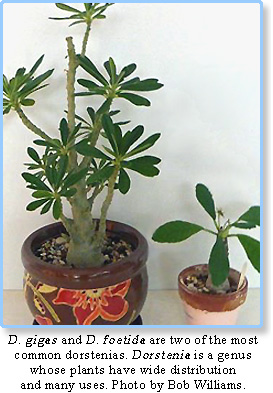Dorstenia (2019)
By Bob Williams (July 2019)
 The ficus tree, fig trees, Osage orange, Dorstenia gigas – a strange combination of plants, but they do have something in common. They all belong to the family Moraceae.
The ficus tree, fig trees, Osage orange, Dorstenia gigas – a strange combination of plants, but they do have something in common. They all belong to the family Moraceae.
Moraceae is sometimes called the fig or mulberry family. This is a family of flowering plants consisting of 38 genera and over 1,100 species. When looking at the four plants above, one would wonder how members of the genus Dorstenia could be like an Osage orange.
The Moraceae family is comprised mainly of woody plants. Dorstenias are mainly succulent. Most are small, growing to a height of 10 to 20 inches. Dorstenias do share some common characteristics with their plant brothers. The sap of species in the Moraceae family is milky white, but not poisonous like that of euphorbias. The flowers are inconspicuous, and they produce compound fruits. The other interesting fact is this family traces its “roots” back 135 million years.
According to most literature, there are from 110 to 170 species in the genus Dorstenia. About 10 to 15 species seem to be of interest to those of us in the succulent hobby. D. gigas and D. foetida are two of the most common.
The genus is widespread, occurring in northeast Africa, the Arabian Peninsula, Madagascar, and Central and South America. Only one species is found east of Saudi Arabia, in the tropical forests of southern India and Sri Lanka. Dorstenia is named in honor of the German physician and botanist Theodor Dorsten (1492-1552).
There are many uses for these plants. In Oman, the tubers of D. foetida are cooked and eaten. A powder made from the rootstocks and leaves of D. contrajerva is mixed with tobacco to improve the taste of cigarettes.
There are also many medicinal uses for these plants. D. psilurus is used in African folk medicine in case of snakebite, rheumatism, headache, stomach ache or hypertension. It is also used in cancer and diabetes treatments. A good description of the medicinal uses for dorstenias can be found on the Science Direct website at https://www.sciencedirect.com/topics/agricultur al-and-biological-sciences/dorstenia.
One of the more distinct features of dorstenias is their “flowers.” Dorstenias are sometimes called shield flower plants. The flower is not a true flower, but a pseudanthium (Greek for “false flower”) – clusters of bisexual flowers on disc-shaped receptacles that are variable in size and shape. The female flowers within the receptacles mature first. The male flowers are scattered among the female flowers, concentrated on the outer edge of the receptacle or separated by a flower-free zone at the outer edge.
 Dorstenia species have drupelike fruits that are embedded in the “flowers.” A drupe is a seed pod that has a fleshy outer layer with a single seed inside. A special feature of dorstenia drupes is that they explode to release and scatter the seeds. The seeds can be cast out 3 or 4 feet from the plant. If you want to collect seeds, some sort of fine netting is required, as the seeds are small. Expect some sprouts in nearby plants in any case.
Dorstenia species have drupelike fruits that are embedded in the “flowers.” A drupe is a seed pod that has a fleshy outer layer with a single seed inside. A special feature of dorstenia drupes is that they explode to release and scatter the seeds. The seeds can be cast out 3 or 4 feet from the plant. If you want to collect seeds, some sort of fine netting is required, as the seeds are small. Expect some sprouts in nearby plants in any case.
Some documentation on dorstenias states the plants are not self-fertile and that two plants are needed for pollination.
The plants seem to be fairly easy to grow. They can take full sun and like higher temperatures. Like all succulents, a porous soil is a must. During the growing season, the plants appreciate a fair amount of water, but allow the soil to dry slightly between watering, making sure it never dries out completely.
During the winter months, dorstenias tend to go at least partially dormant and exhibit some leaf loss. A small amount of watering is required. They should be kept in a warmer room during the winter. They show some stress when kept where the temperature goes below 50 degrees.
Dorstenia gigas is one of the species I have in the genus. This is the largest species of the genus and is found on the island of Socotra. This plant can grow to 15 feet tall and 3 feet in diameter. As the plant grows taller, it branches out and becomes shrublike. In cultivation, the growth and branching resembles that of an adenium.
At the last meeting, I was asked to write an article on dorstenias. I am always open to suggestions on a Plant of the Month. These articles are for our members. If anyone has a suggestion, I will be glad to research it and write an article. Please contact me at rusty342@aol.com.
Sources:
Wikipedia – https://en.wikipedia.org/wiki/Dorstenia, https://en.wikipedia.org/wiki/Moraceae
The Plant List – http://www.theplantlist.org/browse/A/Moraceae/Dorstenia/
Llifle Encyclopedia of Succulents – http://www.llifle.com/Encyclopedia/SUCCULENTS/Family/Moraceae/16420/Dorstenia_gigas
